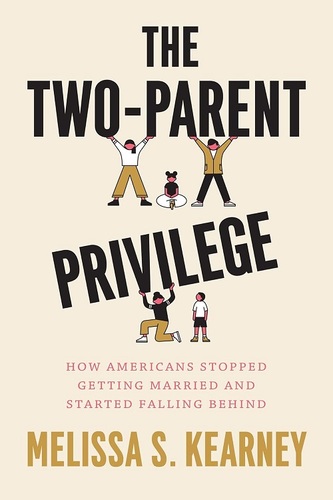
(function(d, s, id) { var js, fjs = d.getElementsByTagName(s)[0]; if (d.getElementById(id)) return; js = d.createElement(s); js.id = id; js.src = “https://connect.facebook.net/en_US/sdk.js#xfbml=1&version=v3.0”; fjs.parentNode.insertBefore(js, fjs); }(document, ‘script’, ‘facebook-jssdk’)); –>
–>
September 18, 2023
The op-ed pages of this Sunday’s New York Times featured a revelation from author Melissa Kearney: “The Explosive Rise of Single Parent Families Is Not a Good Thing.”
‘); googletag.cmd.push(function () { googletag.display(‘div-gpt-ad-1609268089992-0’); }); document.write(”); googletag.cmd.push(function() { googletag.pubads().addEventListener(‘slotRenderEnded’, function(event) { if (event.slot.getSlotElementId() == “div-hre-Americanthinker—New-3028”) { googletag.display(“div-hre-Americanthinker—New-3028”); } }); }); }
Flash to Melissa: a chubby Italian priest named Thomas Aquinas made the same observation about 800 years ago (albeit without noting the aberration was on an “explosive rise”).
Kearney undoubtedly wants to plump her forthcoming book which, based on reviews, seems to be intriguing some liberals. I’m less sanguine, because I think its title, The Two-Parent Privilege: How Americans Stopped Getting Married and Started Falling Behind, betrays a perspective that, in turn, bespeaks an agenda that — unless disavowed — will never solve this “not good thing,” AKA crisis.
The opening paragraph of the Times’ essay does not encourage me:
‘); googletag.cmd.push(function () { googletag.display(‘div-gpt-ad-1609270365559-0’); }); document.write(”); googletag.cmd.push(function() { googletag.pubads().addEventListener(‘slotRenderEnded’, function(event) { if (event.slot.getSlotElementId() == “div-hre-Americanthinker—New-3035”) { googletag.display(“div-hre-Americanthinker—New-3035”); } }); }); }
There has been a huge transformation in the way children are raised in the United States: the erosion of the convention of raising children inside a two-parent home. This shift is often not publicly challenged or lamented, in an effort to be inclusive of a diversity of family arrangements. But this well-meaning acceptance obscures the critical reality that this change is hurting our children and our society.
Yes, there has been a “huge transformation” in child-rearing. But part of that “transformation” comes from speaking of raising children in a two-parent home as a “convention” rather than norm. If Kearney wants to fudge so as not a priori to alienate the chattering classes, well — “norm” can be understood in a sociological (“the ‘norm’ is what most people do) rather than an axiological (“the ‘norm’ is what people should do) sense.
 But I’m not sure this isn’t just an effort to avoid preemptive tune-out. Amazon describes the book as a
But I’m not sure this isn’t just an effort to avoid preemptive tune-out. Amazon describes the book as a
provocative, data-driven case for marriage by showing how the institution’s decline has led to a host of economic woes — problems that have fractured American society and rendered vulnerable populations even more vulnerable. Eschewing the religious and values-based arguments that have long dominated this conversation, Kearney shows how the greatest impacts of marriage are, in fact, economic.
There is a prior question here: is the rearing of children in families composed of two sexually differentiated parents married to each other merely an accidental “convention” that arose due to certain historical and cultural circumstances or is there something “normative” — that this is how things should be — about it? Were history and culture mugged by the tag team of the discriminatory gender binary and the patriarchy? Or, rather, is the ideological baggage of the sexual revolution and gender theory responsible for the deteriorating state of American children?
One can argue a “data-driven case” and, for some Americans for whom quantification results in an intellectual orgasm, that effort may be useful. But describing the “good” (since the title says our current arrangements are not a “good thing”) from a data point of view generally inclines people to think of that good as a “useful good,” something measured in terms of its social utility.
‘); googletag.cmd.push(function () { googletag.display(‘div-gpt-ad-1609268078422-0’); }); document.write(”); googletag.cmd.push(function() { googletag.pubads().addEventListener(‘slotRenderEnded’, function(event) { if (event.slot.getSlotElementId() == “div-hre-Americanthinker—New-3027”) { googletag.display(“div-hre-Americanthinker—New-3027”); } }); }); } if (publir_show_ads) { document.write(“
But we are talking about people and, since both Jesus and Kant, we have been warned against measuring people’s good in terms of usefulness. Perhaps arguing our current parenting arrangements through “economic” analysis might be convincing to some Chamber of Commerce Republicans (those poor kids aren’t going to be good consumers, based on their Experian scores) but that argument, to me, ought to reveal the bankruptcy of the “social conservative” versus “economic conservative” dichotomy. No, Mr. Wall Street, those children are not going to be good consumers because they’ve started and remained lower on the socioeconomic scale. But neither are they going to be good citizens, because, starting lower on that scale and backed up by apologists for “root causes,” they are also likely to vandalize your store, those who passed basic math standards at least doing the elementary calculation of how much larceny they can commit before triggering woke DAs to prosecute.
Pace Kearney’s claim, the shift away from two-parent families has been publicly challenged. It’s just that the mainstream media has refused to report those challenges. At least once upon a time, priests and preachers railed against sexual immorality. Daniel Patrick Moynihan, no right-wing deplorable, wrote about the implosion of the African-American family over 50 years ago. What’s changed is that what he said then of Black families is now true of many American families regardless of race. Social scientists have been documenting the corrosive effects of marriage decline and alternate child-rearing practices for decades: the National Marriage Project has done yeoman work in this field.
To the degree that Kearney’s work helps staunch this social hemorrhage which is damaging both children and women while pretending to “liberation” and “diversity,” I make common cause. But I have my doubts when, out of the gate, it seems to refuse to diagnose a disease as a disease in order to “be inclusive of a diversity of family arrangements.” A child’s right to his mother and father who conceived, bore, and raised him is not a “privilege.” It’s a right of which too many kids have been stripped because their parents want to call their acting as kids “rights.”
John Grondelski (Ph.D., Fordham) was former associate dean of the School of Theology, Seton Hall University, South Orange, New Jersey. All views herein are exclusively his.
Image: Univestiry of Chicago Press
<!–
–>
<!– if(page_width_onload <= 479) { document.write("
“); googletag.cmd.push(function() { googletag.display(‘div-gpt-ad-1345489840937-4’); }); } –> If you experience technical problems, please write to [email protected]
FOLLOW US ON
<!–
–>
<!– _qoptions={ qacct:”p-9bKF-NgTuSFM6″ }; ![]() –> <!—-> <!– var addthis_share = { email_template: “new_template” } –>
–> <!—-> <!– var addthis_share = { email_template: “new_template” } –>





